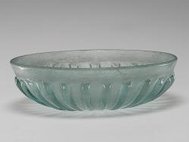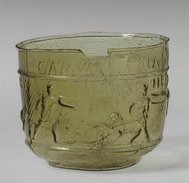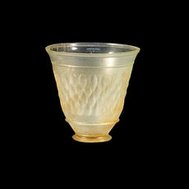
|
|

|
Ancient cast glass
The process of casting glass in moulds was invented in the mid-2nd millennium BC. Although the core-formed method predominated in glass manufacture in the Greek world, casting techniques also played an important role in the development of glass in the ninth to fourth centuries B.C. Cast glass was produced in two basic ways, through the lost-wax method and with various open moulds. The most common method used by Roman glassmakers for most of the open-form cups and bowls in the first century B.C. was the Hellenistic technique of sagging glass over a convex "former" mould. The Romans also adapted various colour and design schemes from the Hellenistic glass traditions, applying such designs as network glass and gold-band glass to new shapes and forms.
Specifically Roman innovations in styles and colours include marbled mosaic glass, short-strip mosaic glass, and the crisp, lathe-cut profiles of a new breed of fine as monochrome and colourless tablewares of the early Empire, introduced around 20 A.D. This type of glassware became one of the most prized styles because it closely resembled luxury items such as rock crystal objects, Arretine ceramics of the Augustan period and bronze and silver tablewares so favoured by the prosperous classes of Roman society. In fact, these fine wares were the only cast glass objects even up to the as Late Flavian, Trajanic, and Hadrianic periods (96–138 A.D.), after glassblowing superceded casting as the dominant method of glassware manufacture in the early first century A.D.



With the discovery of glass blowing in the 2nd half of the 1st century BC a quick and inexpensive method of glass-making was invented in Syria, probably in Phoenicia. Remains from a mid-1st century BC glassmaking refuse dump of a workshop were found in the excavations of the Jewish Quarter in the Old City of Jerusalem. Among the finds were fragments of the earliest blown glass vessels yet discovered. In the course of the 1st century AD, glass blowing was introduced into many parts of the Roman Empire, although, oddly, rather late, in Britain, where first century glass which has been found would have been imported.
Alexandria continued to lead in the production of luxury moulded and cut glass until the early 3rd century AD. Syro-Palestinian glass- blowers maintained a high standard in blowing techniques all through the Roman period. Their mould- blown vessels of the 1st and 2nd centuries AD have remarkable decorations in relief often withGreek inscriptions and in beautiful colors. Ancient cast glass is rather prized by collectors and commands high prices.
Forward to
Ancient Roman glass Ancient Roman glass bottles The colours of ancient Roman glass Ancient glass fakes and forgeries
Go back to


Home | About This Site | Privacy Statement | Gallery | Testimonials | Guarantees
About Collectors' Resources pages | What's New
Search | Site Map | Contact Us